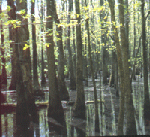| COUNTY: | Hardin | ACREAGE: | 225 |
| 7.5' QUADRANGLE: | Pittsburg Landing | OWNERSHIP: | State of Tennessee |
| PHYSIOGRAPHIC PROVINCE: |
West TN Uplands | YEAR DESIGNATED: | 1997 |
DESCRIPTION: |
 Walker
Branch is a 225-acre natural area located just miles south of Savannah
in Hardin County. The property was purchased with wetland acquisition
funds by TWRA who cooperatively manages the site with the Natural Areas
Program. It is located in the West Tennessee Uplands, a subunit of the
Coastal Plain Physiographic Province. The preserve “straddles”
the immediate floodplain of the Tennessee River with its steep hills rising
abruptly 225 feet and forming the adjacent uplands. Seeps occur along
the lower and mid slopes and drain into the many small spring feed sand
and gravel bottomed creeks at the base of the hills. These seep-fed creeks
flow in and out of the marshes and swamp forests.
Walker
Branch is a 225-acre natural area located just miles south of Savannah
in Hardin County. The property was purchased with wetland acquisition
funds by TWRA who cooperatively manages the site with the Natural Areas
Program. It is located in the West Tennessee Uplands, a subunit of the
Coastal Plain Physiographic Province. The preserve “straddles”
the immediate floodplain of the Tennessee River with its steep hills rising
abruptly 225 feet and forming the adjacent uplands. Seeps occur along
the lower and mid slopes and drain into the many small spring feed sand
and gravel bottomed creeks at the base of the hills. These seep-fed creeks
flow in and out of the marshes and swamp forests.
Undisturbed examples of a bald cypress forest emerge at the base of these hills grading into mature tupelo gum (Nyssa aquatic) forest in the floodplain. A mesic forest comprised of northern red oak, American beech, tulip poplar, and white oak is found on lower to mid slopes. Southern red oak and short leaf pine are dominant species that occur on drier slopes and ridges. The many forest types at Walker Branch provide a colorfully diverse shrub layer ranging from indigo bush, deciduous holly, American beautyberry, big-leafed snowbell, hearts-a-bustin, and wild azalea, as well as other blueberry species.
The upland seeps provide significant breeding habitat for dragonflies and damselflies. An astonishing 37 species of these taxa have been identified at Walker Branch. Examples include Laura’s clubtail, arrowhead spiketail, harlequin darner, great blue skimmer, and the treetop emerald. State rare and endangered plant species that are protected at this preserve include the lake-bank sedge (Carex lacustris) and lamance iris (Iris brevicaulis). There is a vast diversity of sedges, rushes, and ferns in this wet, lush natural area.
SITE MANAGEMENT:
Tennessee Wildlife Resources Agency, 200 Lowell Thomas Drive, Jackson, TN 38301, phone (731) 423-5725. Division of Natural Areas, Jackson Environmental Field Office, 1625 Hollywood Drive, Jackson TN 38305, phone (731) 512-1369. Division of Natural Areas, 7th Floor L&C Annex, 401 Church St., Nashville TN 37243, phone (615) 532-0431.
PUBLIC ACCESS:
Public access is allowed; however no parking or trails are provided at this time.
DIRECTIONS:
From Hwy 64 in Savannah, take Hwy 128 south for approximately 2.5 miles and turn right on Diamond Island Road. Stay left as the road splits at McGinley Loop. At the bottom of the hill turn left again. You are now on Pittsburg Landing Road, and after approximately .4 miles you will enter the natural area. There are no developed parking locations. You may park along Pittsburg Landing Road or in an undeveloped parking area on the east side of the road.



